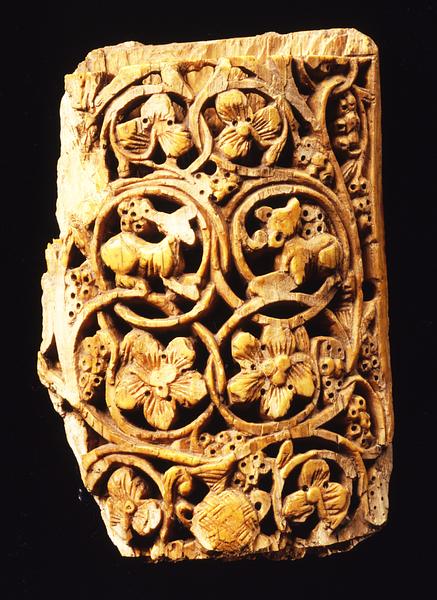Fragmentary plaque, carved ivory
Egypt or Syria; 1st half of 8th century
H: 11.5; W: 7.7 cm
The ivory plaque was probably mounted with similar ones as a decoration on a piece of furniture.
The plaque’s vines, which grow from a little vase and enclose flowers and deer, are characteristic of the forms of decoration used by the Umayyads.
A closely related decoration was used on the facade of the Mshatta palace complex built in the Syrian Desert by the Umayyad caliph al-Walid II in the 740s. What remains of the facade is now found in Berlin.
Vegetal ornamentation of this kind is indebted to the decorations of Late Antiquity that were an important point of departure for Umayyad art.
Inv. no. 20/1978
Published in:
Kjeld von Folsach: Islamic art. The David Collection, Copenhagen 1990, cat.no. 280;
Kjeld von Folsach, Torben Lundbæk and Peder Mortensen (eds.): Sultan, Shah and Great Mughal: the history and culture of the Islamic world, The National Museum, Copenhagen 1996, cat.no. 182
Kjeld von Folsach: Art from the World of Islam in The David Collection, Copenhagen 2001, cat.no. 405;
Ralph Pinder-Wilson: “Ivory working in the Umayyad and Abbasid periods” in Journal of the David Collection, 2005, 2:1, p. 14, fig. 3;
Ángel Galán y Galindo: Marfiles medievales del islam, Córdoba 2005, no. 20056, pp. 344 and 347;
Sheila S. Blair and Jonathan M. Bloom (eds.): Cosmophilia. Islamic Art from the David Collection, Copenhagen, McMullen Museum of Art, Boston College, Boston 2006, cat.no. 114;
Kjeld von Folsach: Flora islamica: plantemotiver i islamisk kunst, Davids Samling, København 2013, cat.no. 8;
Noelia Silva Santa-Cruz: La eboraria andalusí del califato omeya a la Granada nazaríi, Oxford 2013, fig. 8;
Michelina Di Cesare (ed.): Sharing material culture: ivory and bone artefacts from the Mediterranean to the Caspian sea from antiquity to the Middle Ages, Rom 2019, p. 180, fig. 1;
